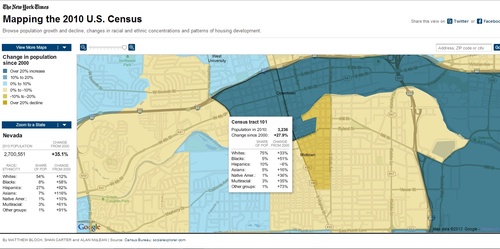Nevada continues to be a fast growing state. Since 2000, the state population has grown 35%. Much of the growth has been from non-Caucasion groups, now approximately 34% of the Nevada population. Latinos make up more than a quarter of the state population (27%).
 This is an example of demographic data shown on The New York Times' census map.
This is an example of demographic data shown on The New York Times' census map.
Percentage increase in total Nevada population from 2000 to 2010:
White: +12% ( Current state total: 54%)
Black: +58% (Current state total: 8%)
Hispanics: +82% (Current state total: 26.5%)
Asians: +116% (Current state total: 7%)
Native American: +10% (Current state total: 1.1%)
Multiracial: +61% (Current state total: 4.6%)
Other groups: +91%
These percentages add up to more than 100% - this is because those with two or more races may be counted in both categories if they do not select the multiracial category.
The 2010 Census Report recorded Reno’s population at 225,221, which is 8 percent of Nevada's total population ( which is about 2.71 million). Reno's median age is 34.2. The report stated that males were the majority gender at 114, 494, though women followed closely at 110,727. Comparatively, men make up 1,363,616 of Nevada's population; women make up 1,336,935, a difference of only 26,681 people.
Ethnicity Statistics
In 2010, there were 167,179 Whites making up the ethnic majority in Reno. Hispanics/Latinos are the biggest ethnic minority, at 54,640 people.
Other Races:
African American: 6,429
Asian: 14,232
American Indian and Alaska Native: 2,835
Native Hawaiian and Pacific Islander: 1,624
Identified by two or more: 9,356
Other: 23,556
Neighborhood Statistics
Neighborhood demographic information is sorted into census tracts, which are statistical subdivisions of a county (in this case, Washoe County). Census tracts are delineated by local census areas committees.
Generally, census tracts contain between 2,500 and 8,000 people, so areas with populations lower than 2,500 are not designated on the neighborhood maps. Keeping this in mind, some census tracts cover a larger area than others and may span several neighborhoods in order to achieve the minimum of a population of 2,500.
These tables shown below are examples of certain neighborhood demographic listings around the city. For information on all the census tracts, view The New York Times’ Census neighborhood data map.
Spanish Springs
Census Tract 3504
| Population | 7,355 |
| Change since 2000 | +209.7% |
| Whites | 80% |
| Blacks | 1% |
| Hispanics | 11% |
| Asians | 3% |
| Native Americans | 1% |
| Multiracial | 3% |
| Other groups | 0% |
Downtown
Census Tract 102: East Downtown (Virginia Street to Galletti Way)
| Population | 3,945 |
| Change since 2000 | +30.4% |
| Whites | 66% |
| Blacks | 7% |
| Hispanics | 16% |
| Asians | 6% |
| Native Americans | 2% |
| Multiracial | 3% |
| Other groups | 1% |
Meadowood Mall and Neil Road
Census Tract 2204
| Population | 4,519 |
| Change since 2000 | -1.3% |
| Whites | 38% |
| Blacks | 3% |
| Hispanics | 48% |
| Asians | 7% |
| Native Americans | 1% |
| Multiracial | 2% |
| Other groups | 0% |
Galena
Census Tract 101: S. Virginia St. to Thomas Creek Road
| Population | 2,672 |
| Change since 2000 | +31.9% |
| Whites | 90% |
| Blacks | 0% |
| Hispanics | 4% |
| Asians | 3% |
| Native Americans | 0% |
| Multiracial | 2% |
| Other groups | 0% |
All demographic data and census information is taken from the 2010 U.S. Census Bureau Report, The New York Times’ Census neighborhood data, and Amherst College.


